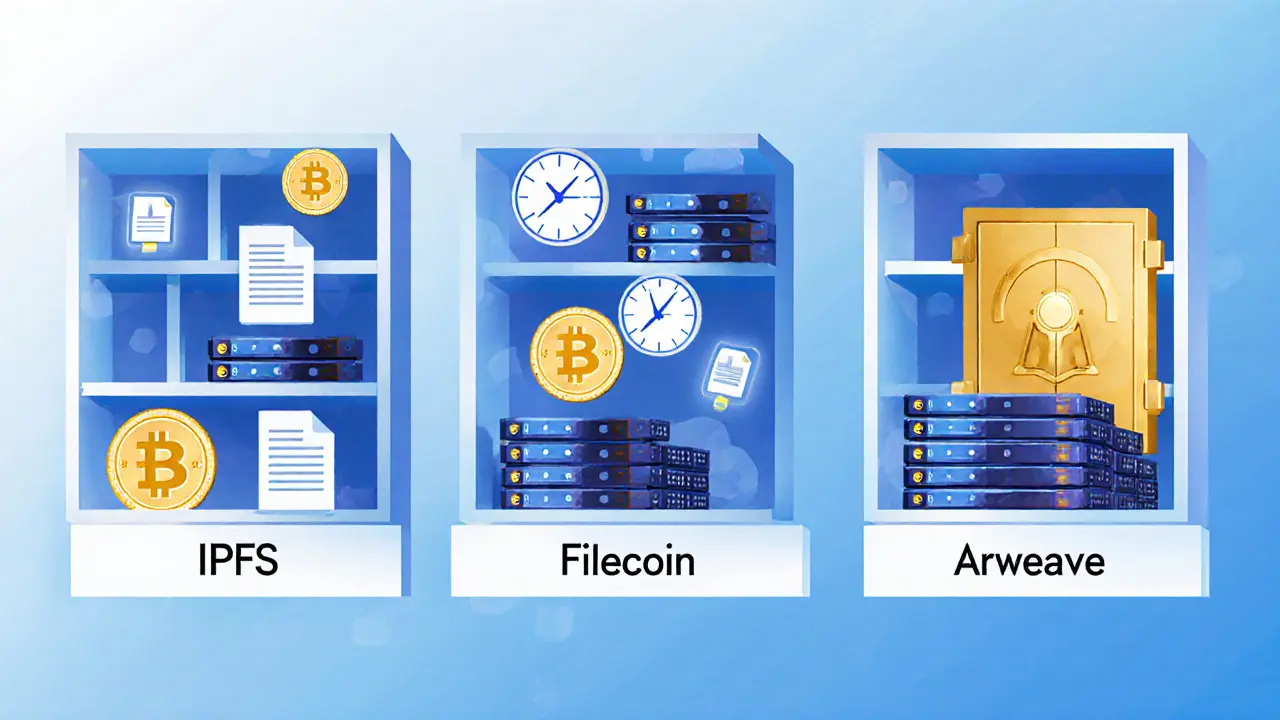Decentralized Storage Cost Calculator
Your Storage Requirements
Cost Comparison
Recommended Solution:
What’s the real difference between IPFS, Arweave, and Filecoin?
You’ve heard the buzz: IPFS, Arweave, and Filecoin are the big names in decentralized storage. But if you’re trying to decide which one to use - whether you’re storing NFT metadata, backing up a DAO’s governance records, or just tired of Amazon’s cloud bills - you need more than marketing slogans. You need to know what actually happens when you upload data, who pays for it, and what happens if you stop paying.
Let’s cut through the noise. These aren’t just different tools. They’re different philosophies.
IPFS: The Content Router, Not the Storage
IPFS - InterPlanetary File System - isn’t storage. It’s a way to find files by what they are, not where they are. Think of it like a library catalog. If you want a book, you don’t ask for the shelf in Room 3, you ask for the ISBN. IPFS does the same with data. Each file gets a unique hash - a digital fingerprint - and anyone on the network can serve it if they have a copy.
But here’s the catch: no one is forced to keep it. If no one pins your file, it vanishes. That’s not a bug. It’s how it works. You’re borrowing space from strangers who might turn off their computers tomorrow.
That’s why most people don’t use IPFS alone. They use pinning services like Pinata. Pinata charges $0.50 per GB per month to keep your files alive. It’s like renting a locker in a shared storage unit. You pay to make sure someone’s watching your stuff.
IPFS is fast. If your file is pinned, retrieval takes 50-150ms. It’s perfect for websites, apps, or anything that gets accessed often. But if you need your data to last 10 years? IPFS won’t save you.
Filecoin: Pay to Store, Renew to Keep
Filecoin built on IPFS - and added a market. It’s a decentralized storage marketplace where people rent out unused hard drive space, and others pay to store data. The key word? Contract.
When you use Filecoin, you sign a time-bound agreement. You pay for 6 months, 1 year, or 5 years of storage. But if you forget to renew? Your data gets deleted. In March 2025, a user lost $147 worth of Filecoin (FIL) after missing a storage proof - and their data vanished. That’s not rare. Over $2.8 million in FIL penalties were issued in Q2 2025 alone for failed storage proofs.
Storage costs range from $200 to $1,000 per terabyte per year. That’s cheaper than Arweave, but you’re paying rent, not buying ownership. It’s perfect for AI training data, video archives, or temporary backups. Sixty-two percent of decentralized AI projects use Filecoin because they need lots of space, but don’t need it forever.
But running a Filecoin miner? That’s a full-time job. You need 128GB RAM, 32TB of storage, and a server-grade CPU. Most users don’t run nodes. They use providers like Filecoin Storage Providers, which handle the complexity - but you still have to manage contracts, renewals, and monitor uptime. It’s powerful, but heavy.

Arweave: Pay Once, Store Forever
Arweave is the weird one. It charges you once - around $3,500 per terabyte - and promises your data will be stored forever. Not 10 years. Not 50. Forever.
How? It uses something called the endowment model. You pay upfront, and part of that money goes into a perpetual fund. Miners are paid from this fund over time, incentivized to keep your data alive for centuries. It’s not magic. It’s math.
Arweave’s network stores over 130 TiB of permanent data. It’s used by 78% of top Ethereum NFT collections for metadata. DAOs store governance votes on it. Libraries archive websites. One Reddit user paid $1,200 to store 400GB of DAO records - and hasn’t touched it since. “Set and forget,” they said.
But there’s a trade-off. That $3,500/terabyte price tag is 3.5 to 17.5 times higher than Filecoin’s annual rate. And while Arweave’s replication factor is 100-1,000 (meaning your data is copied hundreds or thousands of times), the network only has 8,000 nodes - far fewer than IPFS’s 1.2 million. Critics worry that’s not enough to survive a global internet blackout.
Still, Arweave’s 2025 Permavision upgrade cut storage costs by 18% using AI to optimize redundancy. And unlike Filecoin, there’s no contract to renew. No monthly bills. No risk of forgetting. If you care about permanence - and you’re willing to pay for it - Arweave is the only option.
Which One Should You Use?
Let’s cut to the chase.
- Use IPFS if you need fast, frequent access to data you can afford to lose. Great for websites, apps, or testing. Just pair it with Pinata if you need reliability.
- Use Filecoin if you need lots of storage for a limited time. AI datasets, video backups, temporary archives. You’re okay managing contracts and renewals.
- Use Arweave if your data must survive you. NFT metadata, legal records, historical archives, DAO constitutions. Pay once. Never worry again.
Most people don’t pick just one. They use all three together. IPFS for speed, Filecoin for bulk temporary storage, Arweave for the stuff that matters forever.

What’s Next? The Future of Decentralized Storage
Filecoin just launched its Filecoin Virtual Machine (FVM) in January 2025 - letting developers run smart contracts directly on the storage layer. That’s a big deal. It means you can now build apps that automatically pay for storage when users upload files. Companies like AWS and Google Cloud are testing integrations.
Arweave’s Permavision upgrade, rolled out in March 2025, uses AI to predict which data is most likely to be accessed - and stores it more efficiently. That’s why its cost per TB dropped 18%.
Meanwhile, IPFS is adding quantum-resistant encryption to its libp2p stack by late 2025. That’s a quiet but critical move - preparing for a future where today’s encryption breaks.
But the biggest threat? New competitors. Walrus, launching in Q3 2025, promises $50 per TB per year using erasure coding - a fraction of Filecoin’s price. If it works, it could shake up the whole market.
For now, though, the three are complementary. IPFS is the highway. Filecoin is the trucking company. Arweave is the vault.
Real-World Failures and Wins
Not everyone gets it right.
In Q1 2025, 127 GitHub issues were opened by NFT projects because their metadata disappeared. Why? They used IPFS without pinning. Their art vanished. Fans complained. Sales dropped.
On the flip side, Arweave users report 99.999% uptime for their archives. One DAO stored its entire voting history - 12GB of data - for under $1,000. No renewals. No alerts. No panic.
Filecoin users? They’re split. Enterprise teams love the flexibility. But small users? Many quit after 3 months. One miner on the Filecoin forum said they spent 30 hours a month just managing storage deals - then switched back to AWS.
Pinata, the top IPFS pinning service, has a 4.7/5 rating on Trustpilot. But users complain about price spikes during network congestion. That’s the problem with any decentralized system: demand surges = cost surges.
Final Thoughts
There’s no single best solution. The right choice depends on what you’re storing - and why.
If you’re building a website? Use IPFS with Pinata.
If you’re storing 10TB of AI training data for 2 years? Filecoin is your friend.
If you’re archiving something that should outlive governments, corporations, or even your own children? Arweave is the only answer.
The future of data isn’t centralized. But it’s not just decentralized either. It’s layered. And knowing which layer to use - and when - is the real skill.
Can I use IPFS without paying anything?
Yes, you can use IPFS for free. But only if you’re okay with your data disappearing. IPFS doesn’t store files - it just helps you find them. If no one is actively pinning your file, it won’t be available. To make sure your data stays up, you need to pay a pinning service like Pinata, or run your own node.
Is Arweave really permanent?
Arweave is designed to be permanent. You pay once, and part of your payment goes into a fund that pays miners to keep your data alive forever. The network uses a unique consensus mechanism called Proof-of-Access, which forces miners to prove they still have old data to create new blocks. As of 2025, over 130 TiB of data has been stored permanently on Arweave with no major data loss events. It’s not guaranteed by law - but economically and technically, it’s the closest thing we have to digital immortality.
Why is Filecoin cheaper than Arweave?
Filecoin charges annually because it’s a rental model. You’re paying for storage space right now - not for forever. Arweave’s price includes a perpetual fund that pays miners for decades. That upfront cost covers the long-term incentive to keep your data alive. Filecoin’s $200-$1,000/terabyte/year is cheaper in the short term, but over 10 years, you’ll pay more than Arweave’s one-time fee - and you still risk losing your data if you miss a payment.
Can I store NFTs on all three?
You can store the metadata (like the image or JSON file) on all three - but only Arweave guarantees it will stay accessible forever. Most top NFT collections (78% on Ethereum) use Arweave for this reason. IPFS is risky - if the pinning service shuts down, your NFT could become a broken link. Filecoin works if you renew, but if you forget, your NFT’s art disappears. That’s why Arweave is the standard for NFTs that want to last.
Which one is easiest for a developer to use?
IPFS is the easiest. You can integrate it into a website in a few hours using JavaScript libraries. Filecoin is the hardest - setting up a storage miner takes 40-60 hours and requires serious technical know-how. Arweave sits in the middle. Integration takes 8-12 hours, but after that, you’re done. No ongoing maintenance. That’s why many developers start with IPFS, move to Filecoin for bulk storage, and use Arweave for the critical stuff.

alex piner
November 14, 2025 AT 21:33Gavin Jones
November 16, 2025 AT 20:51Mauricio Picirillo
November 18, 2025 AT 01:31Liz Watson
November 19, 2025 AT 11:10Rachel Anderson
November 21, 2025 AT 02:30Hamish Britton
November 21, 2025 AT 07:01Robert Astel
November 22, 2025 AT 10:21Andrew Parker
November 23, 2025 AT 03:33Kevin Hayes
November 24, 2025 AT 23:13Katherine Wagner
November 26, 2025 AT 08:46ratheesh chandran
November 27, 2025 AT 04:32gary buena
November 27, 2025 AT 17:32